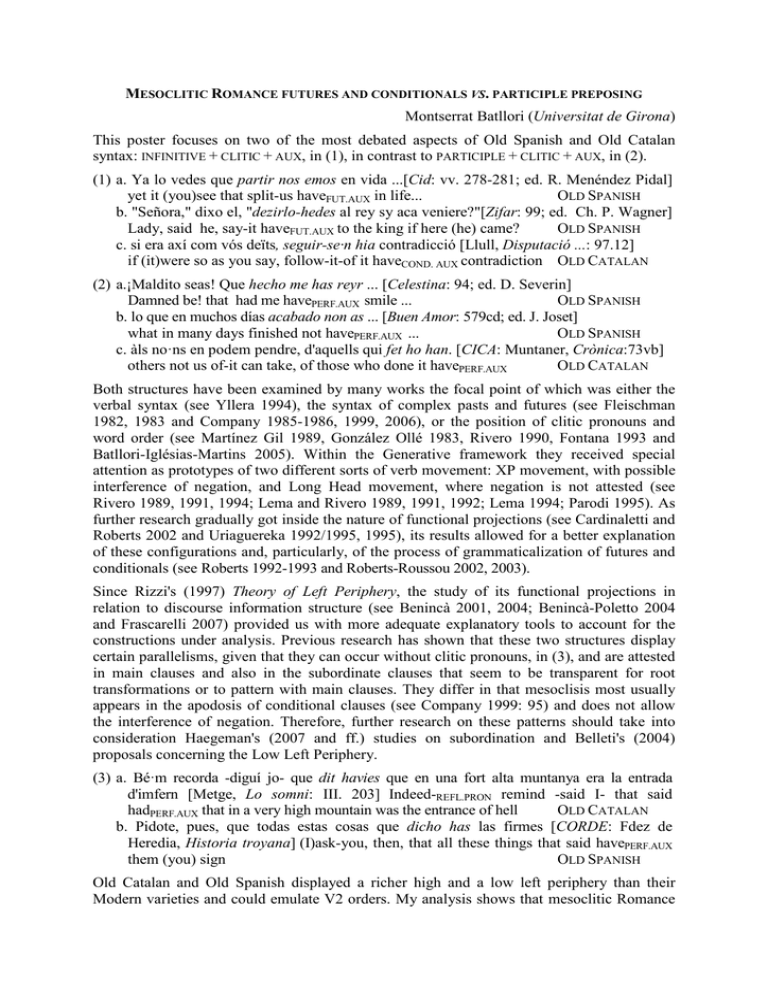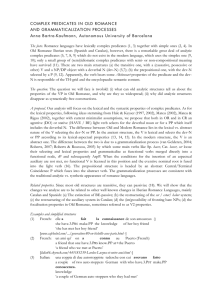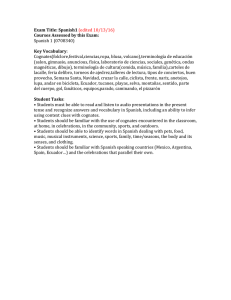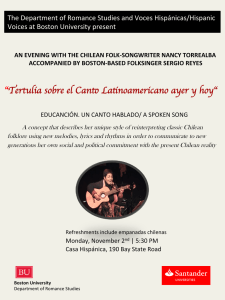Mesoclitic Romance futures and conditionals vs. participle preposing
Anuncio

MESOCLITIC ROMANCE FUTURES AND CONDITIONALS VS. PARTICIPLE PREPOSING Montserrat Batllori (Universitat de Girona) This poster focuses on two of the most debated aspects of Old Spanish and Old Catalan syntax: INFINITIVE + CLITIC + AUX, in (1), in contrast to PARTICIPLE + CLITIC + AUX, in (2). (1) a. Ya lo vedes que partir nos emos en vida ...[Cid: vv. 278-281; ed. R. Menéndez Pidal] OLD SPANISH yet it (you)see that split-us haveFUT.AUX in life... b. "Señora," dixo el, "dezirlo-hedes al rey sy aca veniere?"[Zifar: 99; ed. Ch. P. Wagner] Lady, said he, say-it haveFUT.AUX to the king if here (he) came? OLD SPANISH c. si era axí com vós deïts, seguir-se·n hia contradicció [Llull, Disputació ...: 97.12] if (it)were so as you say, follow-it-of it haveCOND. AUX contradiction OLD CATALAN (2) a.¡Maldito seas! Que hecho me has reyr ... [Celestina: 94; ed. D. Severin] Damned be! that had me havePERF.AUX smile ... OLD SPANISH b. lo que en muchos días acabado non as ... [Buen Amor: 579cd; ed. J. Joset] what in many days finished not havePERF.AUX ... OLD SPANISH c. àls no·ns en podem pendre, d'aquells qui fet ho han. [CICA: Muntaner, Crònica:73vb] OLD CATALAN others not us of-it can take, of those who done it havePERF.AUX Both structures have been examined by many works the focal point of which was either the verbal syntax (see Yllera 1994), the syntax of complex pasts and futures (see Fleischman 1982, 1983 and Company 1985-1986, 1999, 2006), or the position of clitic pronouns and word order (see Martínez Gil 1989, González Ollé 1983, Rivero 1990, Fontana 1993 and Batllori-Iglésias-Martins 2005). Within the Generative framework they received special attention as prototypes of two different sorts of verb movement: XP movement, with possible interference of negation, and Long Head movement, where negation is not attested (see Rivero 1989, 1991, 1994; Lema and Rivero 1989, 1991, 1992; Lema 1994; Parodi 1995). As further research gradually got inside the nature of functional projections (see Cardinaletti and Roberts 2002 and Uriaguereka 1992/1995, 1995), its results allowed for a better explanation of these configurations and, particularly, of the process of grammaticalization of futures and conditionals (see Roberts 1992-1993 and Roberts-Roussou 2002, 2003). Since Rizzi's (1997) Theory of Left Periphery, the study of its functional projections in relation to discourse information structure (see Benincà 2001, 2004; Benincà-Poletto 2004 and Frascarelli 2007) provided us with more adequate explanatory tools to account for the constructions under analysis. Previous research has shown that these two structures display certain parallelisms, given that they can occur without clitic pronouns, in (3), and are attested in main clauses and also in the subordinate clauses that seem to be transparent for root transformations or to pattern with main clauses. They differ in that mesoclisis most usually appears in the apodosis of conditional clauses (see Company 1999: 95) and does not allow the interference of negation. Therefore, further research on these patterns should take into consideration Haegeman's (2007 and ff.) studies on subordination and Belleti's (2004) proposals concerning the Low Left Periphery. (3) a. Bé·m recorda -diguí jo- que dit havies que en una fort alta muntanya era la entrada d'imfern [Metge, Lo somni: III. 203] Indeed-REFL.PRON remind -said I- that said hadPERF.AUX that in a very high mountain was the entrance of hell OLD CATALAN b. Pidote, pues, que todas estas cosas que dicho has las firmes [CORDE: Fdez de Heredia, Historia troyana] (I)ask-you, then, that all these things that said havePERF.AUX them (you) sign OLD SPANISH Old Catalan and Old Spanish displayed a richer high and a low left periphery than their Modern varieties and could emulate V2 orders. My analysis shows that mesoclitic Romance futures and conditionals are instances of focus fronting to a low focus position located to the left of the low vP phase (in the lines of Poletto 2006), while participle preposing structures are examples of both main and subordinate Weak Focus Fronting to the high left periphery (see Batllori-Hernanz 2010). I take the Latin origin of the mesoclitic constructions to be modal periphrases (see Yllera 1973), the order of which infinitive with respect to the finite verb was due to information structure distribution. Thus, mesoclisis in Old Spanish and Old Catalan would follow the Latin pattern, yielding an analysis as follows: [CP [ModP.oblig. [deziri vosj]k [Mod.oblig. emos] [Low TopicP [Low FocusP [Low Focus tk][vP [VP ti tj]]]]] This accounts for: 1) its presentational value (see Fernández Ordóñez 2008-2009: 13), 2) the lack of interference of negation, and 3) its behavior as a modal periphrasis with deontic value. Bibliographical references Batllori, M. & M-Ll. Hernanz. 2010. Sentential Focus and Polarity: Asymmetries between Spanish and Catalan. Poster: 12th Diachronic Generative Syntax Conference. July, 14th to 16th, 2010, Queen's College, University of Cambridge. Batllori, M.; N. Iglésias & A.M. Martins. 2005. Sintaxi dels clítics pronominals en català medieval. Caplletra, 38: 137-177. Belletti, A. 2004. Aspects of the Low IP Area. In L. Rizzi (ed.). The Structure of CP and IP, 16-51. Oxford: Oxford University Press. Benincà, P. 2001. The Position of Topic and Focus in the Left Periphery. In G. Cinque and G. Salvi (eds.). Current Studies in Italian Linguistics Offered to Lorenzo Renzi. Dordrecht: Foris: 39-64. Benincà, P. 2004. The Left Periphery of Medieval Romance. In Studi Linguistici e Filologici Online. Rivista Telematica del Dipartimento di Linguistica dell’Università di Pisa: 243-297. [http://www.humnet.unipi.it/slifo/2004vol2/Beninca2004.pdf] Benincà, P. & C. Poletto. 2004. Topic, Focus and V2: Defining the CP sublayers. In L. Rizzi (ed.). The Structure of CP and IP: The Cartography of Syntactic Structures. Oxford: OUP: 52-75. Cardinaletti, A. & I. Roberts. 2002. Clause Structure* and X-Second. In G. Cinque (ed.). The Structural Cartography of the Clause, Cambridge: Cambridge University Press: 123-166. Company Company, C. 1985-1986. Los futuros en el español medieval: sus orígenes y su evolución. Nueva Revista de Filología Hispánica. 34: 48-107. Company Company, C. 1999. Sintaxis motivada pragmáticamente. Futuros analíticos y futuros sintéticos en el español medieval. Revista de Filología Española. 79.1-2: 65-100. Company Company, C. 2006. Tiempos de formación Romance II. Los futuros y condicionales. In C. Company (dir.), Sintaxis histórica de la lengua española: La frase verbal, México, D.F, UAM-FCE: 347-418. Fernández Ordóñez, I. 2008-2009. Orden de palabras, tópicos y focos en la prosa alfonsí. Alcanate VI: 139-172. Fleischman, S. 1982. The future in thought and language: Diachronic evidence from Romance, Cambridge: Cambridge University Press. Fleischman, S. 1983. From pragmatics to grammar: diachronic reflections on complex pasts and futures in Romance. Lingua, 60: 183-214. Fontana, J. M. 1993. Phrase Structure and the Syntax of Clitics in the History of Spanish. Unpublished PhD Dissertation, University of Pennsylvania. Frascarelli, M. 2007. Subjects, topics and the interpretation of referential pro: An interface approach to the linking of (null) pronouns. Natural Language and Linguistic Theory, 25: 691-734. González Ollé, F. 1983. Enclisis pronominal en el participio de las perífrasis verbales. Revista de Filología Española. LXIII, 1-2: 1-32. Haegeman, L. 2007. Operator movement and topicalization in adverbial clauses. Folia Linguistica 41: 279-325. Haegeman, L. 2010. The internal syntax of adverbial clauses. In K. Grohmann & I. Tsimpli (eds.). Exploring the left periphery. Lingua thematic issue, 120: 628-648. Lema, J. 1994. Los futuros medievales: sincronía y diacronía. In V. Demonte (ed.). Gramática del Español. México, El Colegio de México. Publicaciones de la Nueva Revista de Filología Hispánica. VI: 139-166. Lema, J. & M.L. Rivero. 1989. Long Head Movement: ECP vs. HMC. NELS, 20: 333-347. Lema, J. & M.L. Rivero. 1991. Types of verbal movement in Old Spanish: Modals, Futures and Perfects. Probus, 3: 1-42 and 237-278. Lema, J. & M.L. Rivero. 1992. Inverted Conjugations and Verb-second Effects in Romance. In C. Laeufer and T. A. Morgan (eds.). Theoretical Analyses in Romance Linguistics, Amsterdam: John Benjamin. Martínez-Gil, F. 1989. Las inversiones del orden de palabras en el Romancero. Hispania, 72: 895-908. Parodi, C. 1995. Verb Incorporation and the HMC in XVIth Century Spanish. In J. Amastae, G. Goodall, M. Montalbetti and M. Phinney (eds.), Contemporary Research in Romance Linguistics, Amsterdam, John Benjamins: 307-317. Poletto, C. 2006. Parallel phases: a study on the high and low left periphery of Old Italian. In M. Frascarelli (ed.), Studies in Generative Grammar, Berlin, Mouton de Gruyter: 261-294. Rivero, M.L. 1989. Estructura flexional y movimiento(s) de verbo: futuros, condicionales y perfectos en rumano y español medieval. In R. Lorenzo Vázquez (Coord.). Actas do XIX Congreso Internacional de Lingüística e Filoloxía Románicas, Santiago de Compostela, vol I: 729-742. Rivero, M.L. 1990. Clitic and NP Climbing in Old Spanish. In H. Campos and F. Martínez-Gil (eds). Current Studies in Spanish Linguistics, Washington: Georgetown University Press: 1-42. Rivero, M.L. 1991. Long Head Movement vs. V2, and Null Subjects in Old Romance. In J. van Marle (ed,), Historical linguistics 1991: papers from the 10th International Conference on Historical Linguistics, Amsterdam, 12-16 August 1991, Amsterdam: John Benjamins. Rivero, M.L. 1994. Auxiliares léxicos y auxiliares funcionales. In V. Demonte (ed.), Gramática del Español, México, El Colegio de México. Publicaciones de la Nueva Revista de Filología Hispánica. VI: 107-138. Rizzi, L. 1997. The Fine Structure of the Left Periphery. In L. Haegeman (ed.). Elements of Grammar. Handbook in Generative Syntax. Dordrecht: Kluwer: 281-337. Roberts, I. 1992-1993. A formal account of grammaticalisation in the history of Romance futures. Folia Linguistica Historica. XIII, 1-2, pp. 219- 258. Roberts, I. & A. Roussou. 2002. The History of the Future. In D. Lightfoot (ed). Syntactic effects of morphological change, Oxford: Oxford University Press:23-56. Roberts, I. & A. Roussou. 2003. Syntactic Change. A Minimalist Approach to Grammaticalization. Cambridge: Cambridge University Press. Uriagereka, J. 1992. A Focus Position in Western Romance. Ms., 1992 Girona Summer School in Linguistics. Uriagereka, J. 1995. Aspects of the syntax of clitic placement in Western Romance. Linguistic inquiry.26: 79123. Uriagereka. J. 1995. An F. Position in Western Romance. In K. É. Kiss (ed.). Discourse Configurational Languages, Oxford: Oxford University Press: 153-175. Yllera, A. 1973. Sintaxis histórica del verbo español: Las perífrasis medievales, Zaragoza: Universidad de Zaragoza. ǧ










